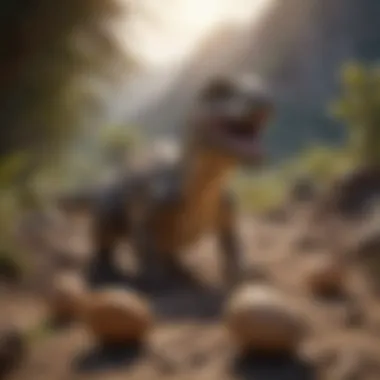Exploring Dinosaur Eggs: Science Meets Imagination


Intro
The intersection of paleontology and imagination presents a unique canvas on which to explore the concept of dinosaurs and their eggs. This exploration is not merely academic; it engages with the curiosities and fears that these ancient creatures invoke in society. The portrayal of dinosaur eggs plays a pivotal role in shaping public perception, driving both scientific inquiry and fantastical narratives.
This article seeks to illuminate various facets of dinosaur reproduction, the historical significance of their eggs, and the ongoing cultural dialogues inspired by this imagery. By bridging factual data with imaginative retellings, we aim to enrich the discussion around these remarkable subjects.
Fascinating Facts About the Animal
In understanding dinosaurs and their eggs, it is beneficial to highlight some fascinating aspects of the creatures themselves.
Unique Characteristics
Dinosaurs exhibited a diverse range of characteristics, from the massive Tyrannosaurus rex to the agile Velociraptor. They displayed adaptations suited to their environments, whether in size, dietary preferences, or locomotion. Some dinosaurs had feathers, which raises intriguing questions about their behavior and evolution linked with modern birds. Their reproductive strategies also varied widely, with some laying large clutches of eggs while others may have been more selective.
Extraordinary Abilities
The extraordinary abilities of dinosaurs were shaped by millions of years of evolution. Some species, such as the Brachiosaurus, were equipped with long necks to reach vegetation high in trees, while predatory dinosaurs like the Spinosaurus possessed features suited for aquatic hunting. These adaptations highlight the remarkable ways in which these creatures thrived in their respective ecosystems.
Behavior and Habitat
Understanding the behavior and habitat of dinosaurs provides context for their reproductive strategies.
Natural Habitats
Dinosaurs inhabited a wide variety of ecosystems, from dense forests to arid plains. Fossil evidence suggests that different species were adapted to specific habitats, influencing their nesting behaviors. For instance, the discovery of nests in certain regions indicates that some dinosaurs may have preferred specific environments for egg-laying.
Social Structures
The social structures of dinosaurs also varied significantly. Some species, like the Triceratops, are believed to have engaged in social behavior and group dynamics, while others may have been more solitary. Such behaviors can inform our understanding of nesting habits and parental involvement in caring for eggs.
Recent Scientific Discoveries
The field of paleontology continues to evolve, yielding new insights into dinosaur biology and reproduction.
Latest Research Findings
Recent studies have revealed much about the structure and formation of dinosaur eggs. Techniques such as advanced imaging and chemical analysis are helping scientists understand egg composition and the conditions under which they were formed. This research is crucial for piecing together the life cycles of these ancient reptiles.
Breakthroughs in Animal Biology
Breakthroughs in animal biology also shed light on the evolutionary link between modern birds and dinosaurs. The discovery that certain dinosaur eggs had similar chemical signatures to those of birds suggests a more nuanced understanding of reproductive evolution within this lineage.
Cultural Significance
The portrayal of dinosaurs and their eggs in various forms of media reflects our ongoing fascination with these creatures.
Animals in Folklore
Dinosaurs often appear in folklore and myth, shaping cultural perceptions of the prehistoric world. This legacy influences how we view their eggs today, both as scientific artifacts and as symbols of wonder.
Influence on Art and Literature


In literature and art, the image of dinosaur eggs captivates audiences of all ages. From children's books to blockbuster films, narratives surrounding dinosaur reproduction and survival resonate strongly. These portrayals not only entertain but also inspire curiosity about paleontological science.
Modern media contributes significantly to the public's understanding of dinosaurs, blending imagination with factual science. Through such narratives, people become more engaged with the field of paleontology.
The ongoing exploration of dinosaurs and their eggs reflects a rich tapestry woven from scientific inquiry and imaginative storytelling. This investigation not only informs but also enriches our understanding of the past.
Foreword to Dinosaur Eggs
The topic of dinosaur eggs holds significant relevance in understanding the world of paleontology and its intersection with imagination. Exploring this topic provides insights into both the scientific and cultural dimensions of dinosaurs and their reproductive strategies. The study of dinosaur eggs can illuminate aspects of prehistoric life that are otherwise hidden from view. Not only does it help establish a timeline for dinosaur evolution, but it also accentuates the methodology of reproduction in different species. Moreover, as these eggs are discovered, they unlock stories of their environments and behaviors, enriching our comprehension of these extinct creatures.
Understanding Dinosaur Reproduction
Dinosaur reproduction is a complex process that reflects evolutionary strategies developed over millions of years. Dinosaurs, members of the clade Archosauria, exhibited various reproductive health and nesting behaviors. Contrary to some misconceptions, many dinosaurs laid eggs, just as modern birds and reptiles do. The size and shape of their eggs varied significantly. Some were small and round, while others were elongated. This diversity hints at the variety within different species. Researchers posit that the patterns seen in egg sizes correlate with environmental factors and the habitats in which the dinosaurs lived.
Reproductive strategies among dinosaurs are fascinating. Certain species engaged in communal nesting or laid their eggs in specific arrangements. These behaviors suggest a social structure that is more advanced than previously understood. Understanding these reproductive mechanisms offers insight into the broader ecosystem dynamics during the Mesozoic era. By studying fossilized remains and egg sizes, paleontologists can discern aspects of mating rituals and parental care that might have been prevalent among various species.
Discovery of Fossilized Eggs
The discovery of fossilized dinosaur eggs is vital for paleontologists. Fossils provide a window into the past, enabling researchers to reconstruct environmental conditions. In places like the Gobi Desert or China’s Liaoning Province, numerous fossilized nests have been found. These discoveries reveal information about dinosaurs’ nesting habits and reproductive behaviors.
In some nests, multiple eggs were found together, often exhibiting arrangements that reflect maternal care. The age of these eggs can often be estimated, revealing critical data about the reproductive timeline of different species.
Such discoveries help piece together the life cycles of dinosaurs and the biodiversity of ecosystems they inhabited.
The location and condition of these eggs offer valuable insights. Fossilized eggs can show evidence of predation or even contain fossilized embryos. These embryos often display features identifiable to specific species, allowing scientists to infer various evolutionary paths. Thus, the study of fossilized eggs serves as an essential tool to understand not only dinosaur biology but also the ecological contexts of their time.
The biology of dinosaur eggs not only sheds light on reproductive strategies but also connects us to the broader evolutionary narrative.
This inquiry into the biology behind dinosaur eggs underscores their importance in the paleontological record, enhancing our grasp of ancient life and how it informs our modern understanding of biodiversity.
Paleontological Significance of Dinosaur Eggs
Dinosaur eggs hold great importance in the field of paleontology. They are not just remnants of the past; they provide essential insights into the behavior and biology of dinosaurs. The study of these eggs allows scientists to infer nesting habits, parental care, and reproductive strategies of various dinosaur species. Understanding these aspects reveals much about the ecology and life cycles of these ancient creatures. Moreover, fossils of dinosaur eggs can offer a unique glimpse into the environmental conditions of the era when they were laid, thus improving our overall understanding of prehistoric ecosystems.
Clues to Dinosaur Behavior
The analysis of dinosaur eggs provides valuable clues about their behavior. For example, fossils from certain nests indicate how dinosaur parents cared for their young. Some species, like the Oviraptor, show evidence of brooding, where adults would sit on their eggs, similar to modern birds. This behavior suggests a level of parental investment not typically associated with reptiles.
Additionally, the arrangement and size of the eggs can reveal patterns of reproductive behavior. Nests containing multiple eggs arranged in a circular pattern suggest communal nesting, an indication of social behavior among certain dinosaur species. This social structure may show how dinosaurs adapted for survival.
The Role of Dinosaurs in Cultural Imagination
The concept of dinosaurs plays a significant role in cultural imagination. This extends beyond mere fascination with these ancient creatures. It involves the way they influence narratives across various forms of media, shaping societal perceptions about evolution, extinction, and even our own moral responsibilities towards nature. In this article, we focus on how dinosaurs serve as a lens through which we examine larger themes within human existence, including survival, adaptability, and the delicate balance of ecosystems.
Dinosaurs in Literature
Literature has long served as a vehicle for exploring the narrative potential of dinosaurs. From classic tales like "The Lost World" by Arthur Conan Doyle to contemporary works targeting younger audiences, dinosaurs have provided rich material for exploration. They evoke themes of adventure, discovery, and even caution against hubris. The presence of dinosaurs in these stories allows authors to address complex ideas about life, extinction, and the consequences of scientific advancement. Furthermore, children's literature often simplifies these creatures into compelling characters, fostering early interest in both reading and paleontology.
Dinosaurs in Film and Media
Film and media offer a powerful platform for interpreting dinosaurs. The visual aspect captivates audiences, making scientific facts accessible and enjoyable. The representation of dinosaurs has evolved significantly over time, reflecting cultural shifts and advancements in technology.
Early Portrayals


Early portrayals of dinosaurs in films often emphasized their monstrous characteristics. Movies such as "King Kong" and early animated features depicted dinosaurs as symbols of primal chaos. These representations contributed to cultural narratives that framed dinosaurs as threats to humanity, reinforcing a sense of fear and fascination. The key characteristic of early films was the reliance on special effects and puppetry, which, while groundbreaking at the time, often led to scientifically inaccurate depictions. Despite their limitations, these films laid the groundwork for a lasting interest in dinosaurs, encouraging an audience to explore paleontology and its associated ethics.
Modern Interpretations
Modern interpretations have transformed the portrayal of dinosaurs, often showcasing them as complex beings with behaviors akin to modern birds and reptiles. Films like "Jurassic Park" leverage advanced CGI technology to create visually compelling narratives. These modern interpretations prioritize scientific accuracy and relatability while still maintaining elements of adventure and thrill. By doing this, they bridge the gap between entertainment and education, enhancing public interest in paleontological research and discovery. However, there is a risk that over-dramatization, as seen in some films, can blur the lines between scientific fact and creative license, potentially spreading misinformation.
The intersection of paleontology and cultural imagination not only highlights the wonders of the ancient world but also prompts us to reflect on our present-day actions toward conservation and the environment.
Overall, the role of dinosaurs in cultural imagination is multifaceted. Literature, film, and other media continue to shape how society perceives these ancient beings and their significance. As paleontological research evolves, so too do the narratives surrounding dinosaurs. Such stories will continue to influence both public understanding of science and the moral implications of human behavior towards nature.
Contemporary Interpretations of Eggs with Dinosaurs
Contemporary interpretations of eggs with dinosaurs play a significant role in understanding how we view paleontology today. This section explores various avenues through which these interpretations influence thought, culture, and science. Two key areas are the fictional narratives surrounding dinosaur eggs and their symbolism in modern contexts. These components help bridge the gap between scientific inquiry and imaginative representation.
Fictional Narratives
Children's Literature
Children's literature often presents dinosaurs in a way that captures the imaginations of young readers. Books like "Dinosaurs Love Underpants" series make learning engaging through colorful illustrations and simple plots. This accessibility is vital because it plants seeds of curiosity about the prehistoric world.
The key characteristic of children's literature is its ability to simplify complex concepts. This makes it beneficial for introducing basic ideas about dinosaurs and their eggs to a younger demographic. However, one disadvantage is that such narratives may oversimplify facts, which might lead to misconceptions later on.
Science Fiction
In contrast, science fiction provides a platform to explore more elaborate possibilities related to dinosaurs and their eggs. Works like
Scientific Speculation and Theoretical Models
The exploration of the intersection between paleontology and imaginative concepts often leads to discussions on scientific speculation and theoretical models. This topic is crucial, as it engages with the boundaries of current scientific understanding while also tapping into the realms of possibility. Theoretical models can help us consider how genetics and evolutionary biology might allow for the re-creation of dinosaurs, assuming we could access their DNA. This discussion brings up various aspects such as ethical implications, potential advancements in technology, and the consequences of genetic manipulation.
Genetic Engineering Considerations
Genetic engineering stands at the forefront of contemporary discussions about recreating extinct species, including dinosaurs. With advancements in CRISPR technology and genome sequencing, scientists are increasingly equipped to manipulate DNA. The idea of restoring dinosaur-like traits in modern birds highlights some possibilities.
- Understanding Genes: To recreate a dinosaur, we must understand which genes govern crucial traits. This involves researching the genetic makeup of closely related species, mainly birds.
- Ethical Questions: The manipulation of genes raises ethical considerations that merit serious discussion. If we succeed, what responsibilities would we hold toward these creatures?
- Biological Feasibility: It is vital to assess whether such a project is biologically realistic. The success rate of cloning extinct species is very low, as seen in efforts to clone animals that have gone extinct recently.
Imagine if scientists could reverse-engineer a dinosaur's genetic code. The risks associated with this endeavor are as significant as the potential gains. Some prominent questions involve ecological impact and the consequences of mixing contemporary ecosystems with ancient species.
Cloning Dinosaurs: A Real Possibility?
Cloning dinosaurs raises the tantalizing thought of witnessing creatures that ruled the Earth millions of years ago. However, whether this is a real possibility remains a contentious topic among scientists.
- DNA Degradation: One of the most significant hurdles is the degradation of DNA over time. Fossilized remains often have DNA that is too fragmented for successful cloning.
- Conservation of Species: Consideration must be given to existing species. Would introducing a cloned dinosaur into the current ecosystem be beneficial or harmful? This factor leads to broader discussions about environmental ethics.
- Legal and Scientific Implications: The legal frameworks surrounding genetic manipulation and cloning are complex and vary worldwide. As advancements in this field continue, the potential need for new regulations grows.
Ultimately, while the prospect of cloning dinosaurs may capture the imagination, the practicalities make it a challenging endeavor. This topic embodies the delicate balance between scientific ambition and ethical responsibilities.
"The pursuit of recreating dinosaurs probes the limits of our understanding of genetics and ethics, reflecting our deep-seated desire to connect with the past."
This inquiry into genetic engineering and cloning opens various avenues for understanding our history and what it means for the future of species conservation. By assessing these scientific possibilities, we can critically engage with what it entails as genetics continues to advance.
Public Perception of Dinosaurs and Their Eggs


Understanding the public perception of dinosaurs and their eggs is critical in shaping how society views paleontology and prehistoric life. This topic reveals much about our curiosity and fascination with these ancient creatures. As we explore this intersection, we notice that the ways in which dinosaurs are portrayed can significantly influence educational approaches, scientific interest, and even conservation efforts.
Diverse Reactions to Dinosaur Imagery
Dinosaur imagery evokes a wide range of reactions from people. Some view dinosaurs as fascinating symbols of our planet's distant past. Others might clight these creatures with fear, based on their portrayal in popular media. Movies, books, and documentaries often depict dinosaurs in dramatic or exaggerated ways, which can skew public understanding.
There is a strong contrast between authentic paleontological findings and the sensationalism found in entertainment. For instance, films like "Jurassic Park" often prioritize thrilling narratives over scientific accuracy. This leads to a mesmerizing yet misleading image of dinosaurs, which can create misconceptions. Public fascination is often based on these cinematic experiences rather than factual science.
Additionally, young children often express an enthusiastic admiration for dinosaurs. These feelings can be shaped by toys, cartoons, and educational books. The reaction from children is crucial, as it sets the stage for a lifelong interest in biology and paleontology. In creating a love for these subjects early on, we can inspire future generations to engage with science and conservation.
Educational Implications for Future Generations
The implications of how dinosaurs are presented in media extend to educational settings. Educators face the challenge of correcting misinformation while encouraging curiosity about science. Misinterpretations arising from popular culture might lead to confusion or disinterest in paleontological studies.
Teachers can harness the fascination with dinosaurs by using engaging resources. For example, incorporating documentaries featuring accurate depictions of dinosaurs can help bridge the gap between entertainment and education. Hands-on activities involving fossils or real-life paleontological findings can deepen understanding.
Moreover, curricula should include discussions on how dinosaurs and their eggs are scientifically studied. By presenting dinosaurs not just as mythical creatures but as real beings that walked the Earth, educators can instill a more profound respect for scientific inquiry.
Involving parents and families can also help reinforce the importance of paleontology at home. Engaging in discussions about dinosaurs and their eggs at dinner tables or during family outings to museums is beneficial. This type of knowledge exchange nurtures an environment where children thrive intellectually.
Conservation of Scientific Heritage
Conservation of scientific heritage is pivotal for understanding our planet's history and the organisms that once roamed it. In the context of dinosaur eggs, this conservation encompasses not only the physical remnants but also the associated knowledge and practices related to paleontology. By preserving fossils and the data they yield, we ensure future generations can learn about the ancient world. This contributes to our broader understanding of evolutionary biology and ecology.
Fossil Preservation Efforts
Fossil preservation is a meticulous process that involves several key strategies:
- Excavation Techniques: Proper excavation methods are crucial to minimize damage to the fossils. These techniques often require skilled paleontologists who understand the geological context of the finds.
- Field Conservation: Before fossils are transported to labs, immediate conservation techniques are applied. This may include using protective jackets to stabilize the fossils during transit.
- Laboratory Techniques: In a controlled environment, fossils undergo treatment for stabilization. This could involve consolidating the materials that make up the fossil to prevent decay or crumble.
The value of these efforts transcends mere preservation; they allow scientists to excavate history with care and respect, providing insights into the past ecosystems and behavior of dinosaurs.
Ethical Considerations in Paleontology
Ethics in paleontology is an often-overlooked component but remains essential for the field's integrity. Important considerations include:
- Respect for Cultural Significance: Many fossil sites hold cultural importance for indigenous communities. Engaging with these groups ensures respect for their heritage and often enhances research credibility.
- Scientific Transparency: Publishing findings and sharing data openly fosters collaboration within the scientific community. Avoiding secretive practices ensures that knowledge is accessible for further research and public understanding.
- Responsible Collection Practices: Collecting fossils from sites should follow regulations to prevent over-exploitation. This sustains not just the fossils but also their locations for future researchers.
Maintaining ethical standards lays the foundation for trust and mutual respect in scientific endeavors. Sustainability and integrity ensure that both scientific heritage and public interest are preserved.
Through careful consideration and execution of preservation efforts and ethical practices, we can safeguard the legacy of dinosaurs and enrich our understanding of their existence on Earth.
Ending and Future Directions
The exploration of dinosaur eggs and their implications hold significance not only for paleontology but also for cultural perceptions surrounding these ancient creatures. As we draw this discussion to a close, we recognize several specific elements which shape our understanding of this topic. Firstly, the intersection of science and imagination serves as a crucial domain for further inquiry, as it reflects both our desires to understand the past and our longing to envision possibilities.
Impacts of Modern Research
Modern research has drastically changed the field of paleontology. Continued developments in technology, such as high-resolution imaging and molecular analysis, allow for a deeper investigation of dinosaur eggs. It enhances our capacity to understand the reproductive strategies of dinosaurs. Furthermore, these advancements have implications for conservation efforts as well, directly influencing how fossils are preserved for future study.
Current research is also beginning to analyze the chemical composition of dinosaur eggshells. By contrasting these findings with those of extant species, paleontologists can draw wiser conclusions about the habitats in which these creatures thrived. The integration of technology and analytical techniques can offer insights that were previously beyond reach.
Thoughts on the Future of Paleontological Studies
Looking ahead, the field of paleontology must embrace interdisciplinary approaches. Biologists, geologists, and even artists can collaborate to create a richer understanding of dinosaurs and their environments. This can pave the way for new theories and enhance educational outreach. Public engagement through museums and media can embrace both the scientific rigor and imaginative representation of dinosaurs.
Also, ethical considerations play a crucial role in shaping future studies. As we learn more about the past, we need to ensure that our pursuits do not compromise current ecological values. Paleontology should align with conservation and sustainability goals, allowing us to respect both scientific heritage and the environment we inhabit today.
Future paleontological studies should strive for a balance—one that respects our scientific heritage while promoting ecological stewardship.







